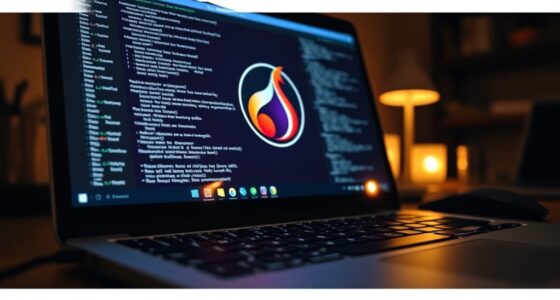Differential privacy is a framework that helps you analyze and share data without exposing individual information. It works by adding carefully calibrated noise to the data or results, balancing privacy and utility. The more noise you add, the better the privacy, but it can reduce accuracy. Conversely, less noise improves precision but weakens privacy. To learn how this technique guarantees privacy while maintaining useful insights, keep exploring its core concepts and applications.
Key Takeaways
- Differential Privacy provides a mathematical framework to analyze data without compromising individual privacy.
- It involves adding calibrated noise to data or results to mask individual contributions.
- The privacy-utility trade-off balances data accuracy with privacy protection, governed by the parameter epsilon (ε).
- Formal guarantees ensure that the presence or absence of a single individual’s data remains statistically indistinguishable.
- It enables secure data sharing and analysis, fostering trust and compliance across sectors like healthcare and finance.

Have you ever wondered how organizations can analyze sensitive data without compromising individual privacy? The answer lies in the concept of differential privacy, a powerful mathematical framework that enables data analysis while preserving privacy guarantees. At its core, differential privacy introduces a technique called noise addition, which involves injecting carefully calibrated randomness into data or query results. This noise masks the contribution of any single individual, ensuring that their presence or absence doesn’t substantially affect the overall output. As a result, you can obtain useful insights without exposing private information.
Differential privacy uses noise addition to protect individual data in analysis and sharing.
When applying differential privacy, you don’t have to worry about revealing specific details about individuals. The noise addition process is designed to balance data utility with privacy protection. The more noise you add, the stronger the privacy guarantees become, but at the expense of accuracy. Conversely, less noise yields more precise results but weaker privacy assurances. This trade-off is fundamental to differential privacy and requires careful tuning based on the context and sensitivity of the data. The goal is to provide a quantifiable privacy guarantee, often expressed as a privacy parameter, epsilon (ε). Smaller values of epsilon mean stronger privacy guarantees because the added noise sufficiently obscures individual contributions.
The strength of differential privacy lies in its formal guarantees. No matter how an attacker tries to analyze the data, the presence or absence of any single individual’s information remains statistically indistinguishable. This property is what makes differential privacy so appealing: it provides a rigorous, mathematical assurance that privacy is maintained throughout the data analysis process. You can confidently share aggregated insights, train machine learning models, or publish datasets, knowing that the privacy guarantees are built into the process. This approach is especially essential in sectors like healthcare, finance, and social sciences, where privacy concerns are paramount.
In essence, differential privacy transforms how organizations handle data. Instead of risking privacy breaches, they can adopt noise addition techniques to ensure individual data points are protected while still extracting valuable patterns. This method not only fosters trust among users but also complies with privacy regulations and ethical standards. As data-driven decision-making becomes more prevalent, understanding and implementing differential privacy will be indispensable. It empowers you to harness the benefits of data analysis without sacrificing the fundamental right to privacy, creating a safer, more responsible approach to data management. A key aspect of differential privacy is noise addition, which involves carefully calibrated randomness to ensure privacy guarantees are met without overly compromising data utility.
Frequently Asked Questions
How Does Differential Privacy Compare to Other Privacy-Preserving Techniques?
You’ll find that differential privacy offers strong privacy guarantees by adding carefully calibrated noise to data, unlike techniques like encryption or anonymization that can be vulnerable. It’s more complex technically, but it balances privacy and data utility well. Compared to simpler methods, differential privacy’s rigorous privacy guarantees make it a top choice, though its technical complexity requires more expertise. Overall, it provides a robust, mathematically sound approach to protecting individual information.
What Are Common Real-World Applications of Differential Privacy?
Like Icarus soaring towards the sun, you’ll find differential privacy elevates data security in real-world applications. You use it to protect healthcare data, ensuring patient confidentiality while sharing insights. It also powers social media analysis, allowing platforms to analyze user trends without exposing individual identities. This technique balances data utility and privacy, enabling organizations to innovate responsibly without risking personal information, much like Daedalus’s careful craftsmanship.
Can Differential Privacy Be Applied to All Types of Data?
You might wonder if differential privacy applies to all data types. While it’s versatile, there are data type limitations. For example, highly sensitive or complex data can pose challenges, often requiring privacy trade-offs like reduced accuracy. Not every dataset benefits equally, so you should evaluate the specific data type and privacy needs before applying differential privacy to guarantee it’s effective and appropriate for your use case.
What Are the Main Challenges in Implementing Differential Privacy?
Imagine you’re balancing data privacy with accuracy, like in a healthcare study. The main challenges in implementing differential privacy include managing the privacy-utility tradeoff, where increasing privacy reduces data usefulness, and dealing with computational complexity, which can slow down processing. These hurdles make it tough to design systems that protect individual data while still providing valuable insights, especially with large datasets or complex algorithms.
How Does Differential Privacy Impact Data Utility and Accuracy?
You might find that differential privacy impacts data utility and accuracy because of the privacy utility tradeoff. To safeguard individual data, noise is added, which can slightly reduce accuracy. However, with careful calibration, you can preserve much of the data’s usefulness. This balance ensures strong privacy while maintaining sufficient accuracy for meaningful analysis, allowing you to optimize both privacy and utility effectively.
Conclusion
You might think differential privacy limits data utility, but it actually strikes a perfect balance between privacy and usefulness. By adding just enough noise, you protect individuals without sacrificing valuable insights. Don’t let the fear of reduced data quality hold you back—embracing this approach can *enable* powerful, privacy-preserving analytics. So, give it a try; safeguarding privacy doesn’t mean sacrificing progress. With differential privacy, you get both security and meaningful data, ensuring responsible innovation.









